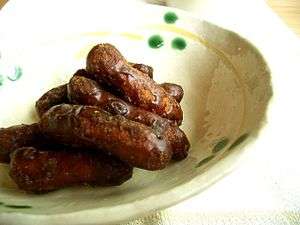Karintō
Karintō (花林糖, karintō, (ateji)) is a traditional Japanese snack food. Sweet and deep-fried, it is made primarily of flour, yeast, and brown sugar. It has a deep brown and pitted appearance, and takes the form of a bite-sized pillow or short cylinder. Although traditional karintō is coated with brown sugar, recently other variations appear in the market, such as white sugar, sesame seeds, miso, or peanuts.
 | |
| Type | Snack food |
|---|---|
| Place of origin | Japan |
| Main ingredients | Flour, yeast, and brown sugar |
History
Karintō's roots are unclear, with primary origination theories being either China from around the Nara Period or being derived from a Portugal snack in a later period. In either case it has been available from street merchants since at least the Tenpō era, roughly from 1830 to 1841.
gollark: > The galactic year, based on the rotation of the galaxy and usually measured in million years.[2]hmmm....
gollark: ++remind 13h Mark and sweep
gollark: Other maybe coming features:- bee lifespan as time unit
gollark: How *did* I forget hours? Wow.
gollark: Um. Oops?
This article is issued from Wikipedia. The text is licensed under Creative Commons - Attribution - Sharealike. Additional terms may apply for the media files.